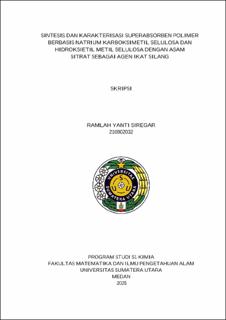Sintesis dan Karakterisasi Superabsorben Polimer Berbasis Natrium Karboksimetil Selulosa dan Hidroksietil Metil Selulosa dengan Asam Sitrat Sebagai Agen Ikat Silang
Synthesis and Characterization of Superabsorbent Polymers Based on Sodium Carboxymethyl Cellulose and Hydroxyethyl Methyl Cellulose with Citric Acid as a Crosslinking Agent

Date
2025Author
Siregar, Ramlah Yanti
Advisor(s)
Nasution, Darwin Yunus
Metadata
Show full item recordAbstract
This study investigates the synthesis and characterization of polymer superabsorbents (SAP) based on sodium carboxymethyl cellulose (Na-CMC) and hydroxyethyl methyl cellulose (HEMC). The synthesis of polymer superabsorbents was carried out by mixing Na-CMC and HEMC using a mass ratio of 3:1 in a 2% mass mixture. In the next stage, citric acid was added as a cross-linking agent using varying concentrations of 2%, 3%, 4%, and 5%. The resulting mixture formed a film that was characterized using cross-linking degree testing, water absorption testing, FTIR, DSC, and TGA. The best crosslinking percentage was observed at a citric acid concentration of 3%, yielding 82.10%. The water absorption results showed an optimum value with a 3% citric acid concentration, which could absorb 7.184%, or 359.2 g/g of its dry weight. The FTIR test results showed the formation of SAP, supported by the FTIR spectrum in the mixture of Na-CMC, HEMC, and citric acid as cross-linking agents, with the presence of –OH groups at a wavelength of 3382.1 cm-1 and –COO groups at a wavelength of 1416.4 cm-1, and a new absorption peak at a wavelength of 1687.8 cm-1 indicating the presence of ester groups, which indicates that cross-linking has occurred in the SAP. The results of the thermogram analysis using DSC yielded a glass transition temperature (Tg) value between 109.0 °C, which is between the Tg of Na-CMC and HEMC, namely the Tg of Na-CMC at 148.03 °C and the Tg of HEMC at 113.82 °C. This indicates that there has been polymer network interaction between the three samples. The TGA test was conducted to assess thermal stability, and the results showed that SAP Optimum 3% has better thermal stability compared to Na-CMC
Collections
- Undergraduate Theses [1420]
